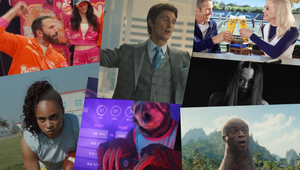
Behind the Work: Valorant’s Fever Dream for the Fans

Last week, to mark the one year anniversary of Riot Games title Valorant’s action-packed world, the studio dropped a frenetic, disorientating sensory overload of a video - the Valorant Year One Anthem.
The four-minute film, directed by Carl Addy with the backing of The Mill, serves as a dedication to the fans, celebrating the “creative audaciousness” that the game encourages. Episodic shots tell the story of each character, capturing past and future anecdotes in an epic film released across all Riot’s digital channels.
Overwhelmed and a little confused by the mixed-media onslaught, LBB’s Alex Reeves caught up with Carl to hear the thoughts and decisions that went into it.
LBB> You worked with Riot Games previously? on their 10-year anniversary film, so you have an ongoing relationship with them. How does that work?
Carl> That was a 45-minute kind of special. It was a total misdirect. So it was set up to be a normal message from [Riot] to the fans, then suddenly they drop the bomb that they're launching a whole bunch of new games. There was all this other stuff going on and it just, you know, kind of blew up the internet. It was ridiculous (as most things Riot do are).
In that process, for me the really interesting thing was working with a company like Riot. I'm very aware that the majority of my normal clients - being agencies and brands and stuff like that as a director - might not really understand what I just made with Riot. Riot are a pure example of the future relationship between brand and consumer. They are all fans together. When Riot makes something for their audience, they're not making an ad to sell a thing. They're literally making something that fans will geek out on, and they've got this incredible feedback loop with their fans in that they're driven to keep those guys entertained and excited and interested, and when fans say that "I'd like a thing," Riot acts on it so quickly. That's such a different, organic way of working.
LBB> How did that culture feed into how you approached the Valorant Year One Anthem project?
Carl> This thing is really just one almost-four-minute-long love letter to the game. It's riddled with Easter eggs and [Valorant] influencers. They're going to need a video essay to explain what's going on.
The whole film is like reincarnation; living and dying and living and dying and famous players and nobody players and how one second you're king of the world the next you're having your ass handed to you.
Within that, we've gotten to leverage details like this huge funeral scene. It's based off of some guy who looks like an up-and-coming influencer type: he gets his ass kicked. (And then you've got this almost minute-long funeral scene.) It's so over the top, just purely to rub his nose in it, in a way. So you don't normally get to do stuff that elaborate, that crafted, that ambitious and audacious. And that's part of what the brief was. They want Valorant to be like the Hypebeast of gaming. What I mean by that is they want the community to be as progressive and future-facing and modern and diverse as the fashion world is. And that's also about creating space for expression; that people will take Valorant content, do their own cosplay, make their own memes, create their own conversation about it. That's part of what makes Valorant so interesting and not like Fortnite and some of those other games - it rewards "audacious creativity," that kind of the moxie of doing stuff that's just so expressive.
LBB> How tight was the brief? I get the impression that it was fairly open - it was more of a vibe.
Carl> This is another testament to the talent of Riot. They have such a high visual aesthetic because they're creating content, graphics, characters, worlds, story arcs, all these things. It's really quite rich.
They had some examples of the vibe that they're going for. One of them was a previous commercial that I did for FIFA20 [with] this kind of kinetic edit and energy throughout. Then they had an example kind of script, like "it could be this kind of thing" - this to that to this to it to this to that.
There are a few things that they wanted to touch on because their audience is so hyper aware and vigilant. Riot wants to portray the creativity of the audience - the cosplayers, the influencers and their audiences - in their tone of voice.
It's content designed for people to scrub through frame by frame to find things that someone else hasn't got yet.
LBB> That's a lot to cram in, especially as you're using gameplay, live-action footage and animation. How did you go about weaving that into a coherent finished piece?
Carl> There's some gameplay stuff in there which [Riot] provided. And we worked with them collaboratively to figure out what was needed. I wanted to avoid suddenly going into a one-minute long gameplay sequence. You've got to edit and short-slice it and craft certain moments to match exactly. And I think the thing about the FIFA [film] they liked was the seamless connection between real life, the game and people's emotion about the game.
There was a lot of quite intricate talk with Riot's developers. Also, they were working with Blur Studio to do a lot of the cinematic, more gorgeous CG narrative stuff. [Both groups] were all integrated into the same process and they were amazing. It was a really wonderful team effort from everybody.
LBB> Beyond that, what were some guiding principles?
Carl> It's always the tricky thing with this type of a brief where you've got people going "I want it to be cool and fashionable," and it's a bit like saying I want something to be funny. You can talk about being funny, or you can just be funny. So it was really important to us that we don't try to be cool. Rather than going, "let's do a funny TikTok moment," let's just do something that's funny. And then, if it feels like it should belong on TikTok, that's great. I think that's why we see so many almost manifesto films these days from brands where you've got cool kids doing cool stuff while a voiceover says what you should be feeling, like "this is our time." It just ends up coming off like we're outside of the conversation, watching other people have all the fun, and also it feels like a really weird pastiche of people's culture.
LBB> You've spoken about how Riot are so in touch with the fans. How did that play into the way that this film took shape?
Carl> You know there's no real division for Riot between who are the players and who are the people working for Riot. They have a good sense of, "oh wait that's a boomer moment, that's not a gamer moment." We also have a guy on our team - Josh Moore - who's a gamer and streamer, and is passionate about this stuff. And he was kept in conversation throughout to make sure that if we were conceptualising something it doesn't feel like we're outside of the conversation.
LBB> What was the process like for feeding back on the edits and iterations of the film?
Carl> You sometimes come across these brands where someone is so scared to offend their audience, or to do something that's gonna make them seem uncool, that they end up diminishing what they put out. It ends up being too safe. And Riot were never about that. The first edit we showed them I thought they were going to say, "too quick and too busy and too insane." They were like, "we think you should be faster."
It needed to feel like a fever dream. At the end this guy wakes up from a nightmare and realises that he's in this weird loop. [Riot] were like, "where's the fever dream you told us about? This isn't fever dream enough! Give us more fever dream." They wanted people to go, "what the fuck?"
Riot know that if they do something as bold as this, their audience will know that if they don't understand it, it means there's something in there that they will understand if they just dig deeper or wait a bit longer. There are a few [YouTube] comments of people saying they want someone to do an explainer video on it. There's a lot of comments like, "is the editor on drugs?"
LBB> Well, the edit is pretty complicated... What were the challenges there?
Carl> Where it really gets tricky is just the technicalities. Dealing with so many different source materials. Like the end sequence, which is this clusterfuck flutter cut of crazy things that are all match cut, so that there is a rhythm to it. That would be hundreds of shots that need to come in at high fidelity and be conformed in for the post guys to be able to work with it. Working in such a huge mixed media thing at this scale and fluidity can be really tough. I've seen lots of films where there's a very neat hand-over from pure live action into a whole animated sequence - just a clean cut point. But blurring the lines between things the way we do; technically it can be a real head fuck. I even hand illustrated stuff on top at the end to try and build more connectivity around it.
LBB> It sounds technically tricky. What was the biggest challenge on the logistic side of things?
Carl> The biggest challenge I would actually say is the sheer scale of the project. We shot for four days in Sofia with a service company called B2Y Productions. They've got Hollywood style street sets where you've got a New York street, a London street. We used four huge studios and honestly the biggest challenge is making sure that you've covered every detail. You need to be alert for the marathon. It's a team challenge; everybody has to be alert.
LBB> It's a massive project with heaps of detail. Is there a specific aspect that you're particularly satisfied with?
Carl> It's so filled with detail. It's the little things. There's a scene in the Tokyo motorcycle sequence where the camera moves over the bike and then falls through the ground as the talent is dragging a character toy that sparks on the ground. We put in sparks to hit the lens and it's just a really nice beautiful detail. The client didn't even know we were going to do this, we just did it and they loved it.
As a sequence, I love the bedroom-to-miniature-to-flamethrower sequence. It just sets up how to kind of humble somebody; their huge winning moment is turned into like a Barbie toy and then flamethrowered. It's so cheeky. I love it.
LBB> Is there anything else you'd like to add about this project?
Carl> The really important thing is that an advert can be more than an advert. An advert can fall into the canon of collectible things that a brand does with its audience. It can be its own piece of entertainment, it can be its own product, in itself, without having to sell anything, and I love that [Riot] think about it that way. It's quite easy I think for a lot of people to look at it and go, "oh that's batshit crazy" and not get the larger point that it's actually its own atomized piece of entertainment.
Additional reporting by Josh Neufeldt.















